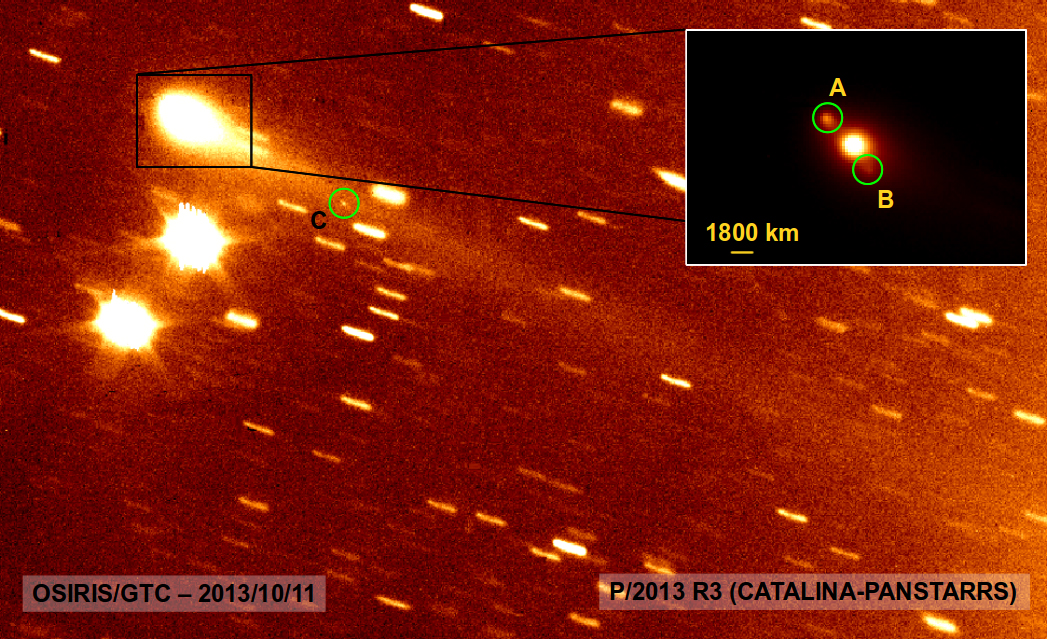Fragmentation of main-belt comet observed for the first time
P/2013 R3 (CATALINA/PANSTARRS) is classified as a "main-belt comet”, an unusual type of asteroid that exhibits similar traits to those of comets
P/2013 R3 (CATALINA/PANSTARRS) is classified as a "main-belt comet”, an unusual type of asteroid that exhibits similar traits to those of comets
The main belt of asteroids, located between Mars and Jupiter, hosts a dense quantity of objects that orbit around the sun in quasi-circular orbits, so that they do not undergo the changes in temperature which are responsible for the characteristic tails that comets leave behind. However, in 1996 a family of asteroids presently comprising a dozen members, which develop comet-like tails and are known as “main-belt comets”, was discovered. One of those asteroids P/2013 R3 (CATALINA/PANSTARRS), recently broke into fragments.
The discovery was made at the Gran Telescopio Canarias (GTC), and it represents a unique opportunity to study the internal structure of main-belt comets and to elucidate the mechanism by which they become asteroids with tails, a sort of hybrid between asteroids and comets. The research team, headed by Javier Licandro of the Institute of Astrophysics of the Canary Islands (IAC), includes researchers from the Institute of Astrophysics of Andalusia (IAA-CSIC).

Comets are made of rock and ice. They come from the outer boundaries of the Solar System (the trans-Neptunian belt and the Oort cloud); as they approach the Sun, the ice in them sublimates and they drag the resulting dust behind them, forming tails. "Main-belt comets exhibit orbits that are typical of main-belt asteroids, not of comets, and we know that it is dynamically practically impossible for a comet to go into such an orbit” says Mr. Licandro (IAC).
“One of the doubts surrounding main-belt comets is the mechanism by which they evacuate dust and form the tails and the coma (the atmosphere surrounding the nucleus) just like comets do", according to the IAC researcher. Until very recently, asteroids were thought to consist of rock and metal, so they could not give rise to a tail like that of comets, or at least not by the same mechanisms.”
The discovery by the Spanish team may turn out very useful for solving this enigma. Main-belt comet P/2013 R3 (CATALINA-PANSTARRS) has broken into at least four pieces through a process of fragmentation which may be similar to that of comets. “The breaking apart could be due to a collision, a rotational rupture or a burst of activity, and we are programming new observations to determine the cause” says Fernando Moreno of the Institute of Astrophysics of Andalusia (IAA-CSIC). “It is an interesting object because it is very bright and it may allow us to detect gases, something we have never been able to do with a main belt comet”, says Mr. Moreno. (IAA-CSIC).
The research team is trying to determine what elements the fragments are composed of in order to ascertain the nature of the nucleus of a main-belt asteroid. For their observations, researchers relied on a device named OSIRIS--part of the Gran Telescopio Canarias, which is situated in the Roque de los Muchachos Observatory in La Palma--as well as on the Sierra Nevada Observatory in Granada.
More information:
- Fernando Moreno, fernando@iaa.es 958230603
- COMUNICACIÓN - INSTITUTO DE ASTROFÍSICA DE ANDALUCÍA: Silbia López de Lacalle, sll@iaa.es 958230532
